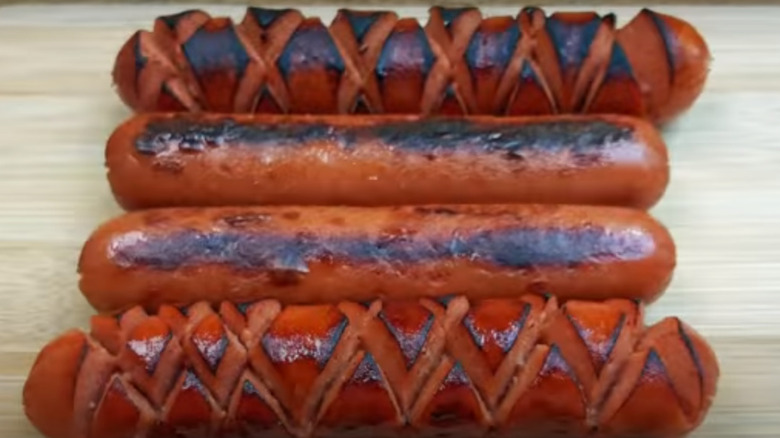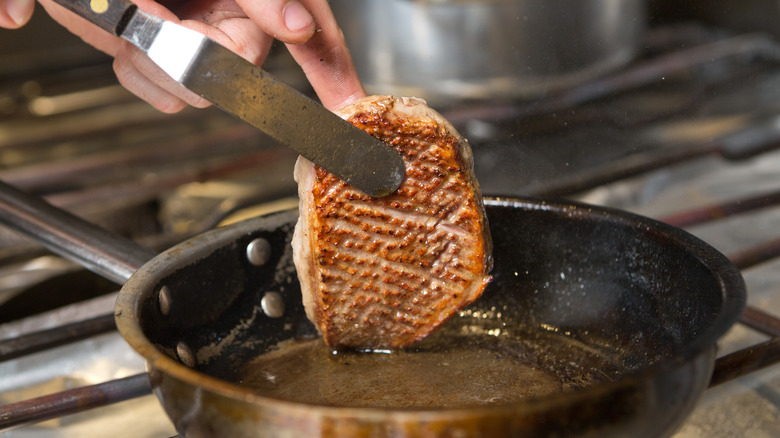Crosshatch Your Hot Dog Before Grilling For The Perfect Crispy Char
There's an undeniable charm to a simple, straightforward hot dog on a bun. The hot dog is a humble food, and that's one of its strengths. On the other hand, one of the virtues of the hot dog's simplicity is that it is something of a blank canvas. Whether we're talking about a Chicago-style hot dog or a bacon-wrapped Sonora dog, this is a grill-top favorite that can be plussed up in so many ways.
That includes finding ways to give your dog the perfect char. You may have seen some chefs or backyard grill masters cutting a few x's into their franks before throwing them on the grill. In theory, the shallow, intersecting cuts are supposed to release a limited amount of fats and juices, leaving most of them intact while allowing the outer layer to get nice and crispy.
Most importantly, this method is intended to ensure an even distribution of heat during the grilling process. We've all been offered a hot dog that's been burnt or burst open unexpectedly while cooking. It's also true that were it better rendered, these slits and chars would actually make for a far better hot dog, rather than one you're eating just because there aren't any non-burnt ones around. To that end, there are a few different options.
Keeping moisture, fat, and flavor in your dog
Ann Taylor Pittman at the Kitchn ran an experiment where she tried a few different slicing patterns before putting her hot dogs on the grill. She tried butterflying the frank, slicing it fishscale-style, spiral-style, and crosshatched. She also tried poaching it before putting it on the grill and just putting it there with no special preparations.
The results of crosshatching were a nice snap on the dog's skin, and a peppering of charred bits evenly distributed across its surface. In preventing unintended splitting, the diagonal, parallel scores allowed heat to escape in a controlled way, and helped retain the juices inside.
Several recipes also specifically call for slathering the frank in various sauces after crosshatching it but before grilling it. The intent is to help evenly distribute the sauce — be it barbecue or honey or any other — the same way as the heat and help it infuse into the hot dog. Partially exposing the frank's insides and letting the flavor really seep deep into it is one of the reasons you also see crosshatching frequently suggested in recipes for smoked hot dogs. It's a somewhat different method of cooking, but the principle remains the same.
More than one way to slice a frank
Hot dogs aren't the only food where some form of scoring is recommended in order to maintain moisture during an even cook, of course. Seared duck breast is usually scored before it's put in the skillet. Certain cuts of beef also benefit from the practice, and Good Housekeeping suggests it for steaks on the grill.
Slicing parallel x's into any cut of meat won't take that long, but it's apparently so popular for hot dogs in particular that there are already time-saving tools like the Slot Dog available for purchase. Granted, using a good old fashioned knife works just as well.
There are, however, as mentioned above, plenty of other ways to slice your frank to get the variance in texture and moisture that you get with crosshatching. One of the more popular is spiraling. It's a bit more labor intensive given that you have to use skewers for your frank, and make sure you keep the same spiral cut going all the way up the dog while keeping it in one piece. This method also keeps a certain amount of moisture inside, though it does seem to emphasize maximum crispiness more than some of the others.


